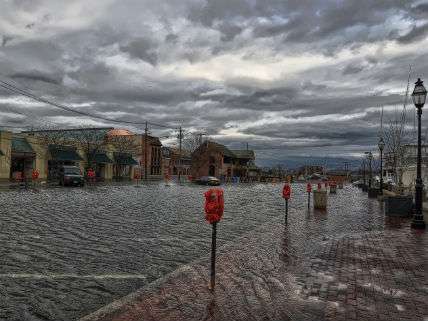20th Century Sea Level Rise Fastest in 2,800 Years
Coastal flooding made worse by sea level rise linked to rising average temperatures

The Proceedings of the National Academy of Sciences is publishing two new studies on global sea level trends and their effects. The first study led by researchers at Rutgers University is based on their analysis of a new data set of regional relative sea level reconstruction that takes into account things like glacial rebound and so forth. They report, as the Rutgers press release notes:
Global sea level rose faster in the 20th century than in any of the 27 previous centuries, according to a Rutgers University-led study published today.
Moreover, without global warming, global sea level would have risen by less than half the observed 20th century increase and might even have fallen.
Instead, global sea level rose by about 14 centimeters, or 5.5 inches, from 1900 to 2000. That's a substantial increase, especially for vulnerable, low-lying coastal areas.
"The 20th century rise was extraordinary in the context of the last three millennia - and the rise over the last two decades has been even faster," said Robert Kopp, the lead author and an associate professor in Rutgers' Department of Earth and Planetary Sciences.
Of particular note, the study also reports that "global sea level declined by about 8 centimeters [3 inches] from 1000 to 1400, a period when the planet cooled by about 0.2 degrees Celsius [0.4 degrees Fahrenheit]." This suggests that sea level fluctuations, largely due to melting or expanding glaciers and icesheets, is fairly sensitive to relatively small changes in global average temperature. It bears keeping in mind that the Last Glacial Maximum, about 21,000 years ago, was 3°C to 5°C cooler than the present. At that time sea level was about 400 feet lower than now. Average global temperature has increased about 1°C over past century or so.
The researchers calculate that "it's very likely that global sea level will rise by 1.7 to 4.3 feet in the 21st century if the world continues to rely heavily upon fossil fuels. Phasing out fossil fuels will reduce the very likely rise to between 0.8 and 2.0 feet."
Another just released report found that the number of nuisance high tide floods in American seaside communities has been considerably exacerbated by the last century's rise in sea level. In fact, the researchers report, according to the New York Times, that "roughly three-quarters of the tidal flood days now occurring in towns along the East Coast would not be happening in the absence of the rise in the sea level caused by human emissions."
For example, in the period between 1955 and 1984 the number of flood days experienced by Boston, Atlantic City, Philadelphia, Washington, Charleston, La Jolla, and San Francisco were 51, 83, 96, 265, 132, 32, and 169 respectively. In the most recent period between 1985 and 2014, the number of flood days in those cities increased to 90, 414, 199, 568, 496, 133, and 286 respectively.
Interestingly, a study from researchers at the Jet Propulsion Laboratory reported earlier in February that thirsty continents were absorbing more water and thus marginally slowing the rate of sea level rise. However, they also report that as the continents' absorptive capacities fill up, the rate of sea level rise will accelerate.
Show Comments (146)